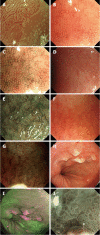Advanced endoscopic imaging in Barrett's oesophagus: a review on current practice
- PMID: 22090782
- PMCID: PMC3214701
- DOI: 10.3748/wjg.v17.i38.4271
Advanced endoscopic imaging in Barrett's oesophagus: a review on current practice
Abstract
Over the last few years, improvements in endoscopic imaging technology have enabled identification of dysplasia and early cancer in Barrett's oesophagus. New techniques should exhibit high sensitivities and specificities and have good interobserver agreement. They should also be affordable and easily applicable to the community gastroenterologist. Ideally, these modalities must exhibit the capability of imaging wide areas in real time whilst enabling the endoscopist to specifically target abnormal areas. This review will specifically focus on some of the novel endoscopic imaging modalities currently available in routine practice which includes chromoendoscopy, autofluorescence imaging and narrow band imaging.
Keywords: Autofluorescence imaging; Barrett’s oesophagus; Chromoendoscopy; High magnification endoscopy; Narrow band imaging.
Figures

References
-
- Acosta MM, Boyce HW. Chromoendoscopy--where is it useful? J Clin Gastroenterol. 1998;27:13–20. - PubMed
-
- Canto MI. Staining in gastrointestinal endoscopy: the basics. Endoscopy. 1999;31:479–486. - PubMed
-
- Kouklakis GS, Kountouras J, Dokas SM, Molyvas EJ, Vourvoulakis GP, Minopoulos GI. Methylene blue chromoendoscopy for the detection of Barrett’s esophagus in a Greek cohort. Endoscopy. 2003;35:383–387. - PubMed
-
- Canto MI, Setrakian S, Willis J, Chak A, Petras R, Powe NR, Sivak MV. Methylene blue-directed biopsies improve detection of intestinal metaplasia and dysplasia in Barrett’s esophagus. Gastrointest Endosc. 2000;51:560–568. - PubMed
-
- Canto MI, Setrakian S, Willis JE, Chak A, Petras RE, Sivak MV. Methylene blue staining of dysplastic and nondysplastic Barrett’s esophagus: an in vivo and ex vivo study. Endoscopy. 2001;33:391–400. - PubMed
Publication types
MeSH terms
Substances
LinkOut - more resources
Full Text Sources

